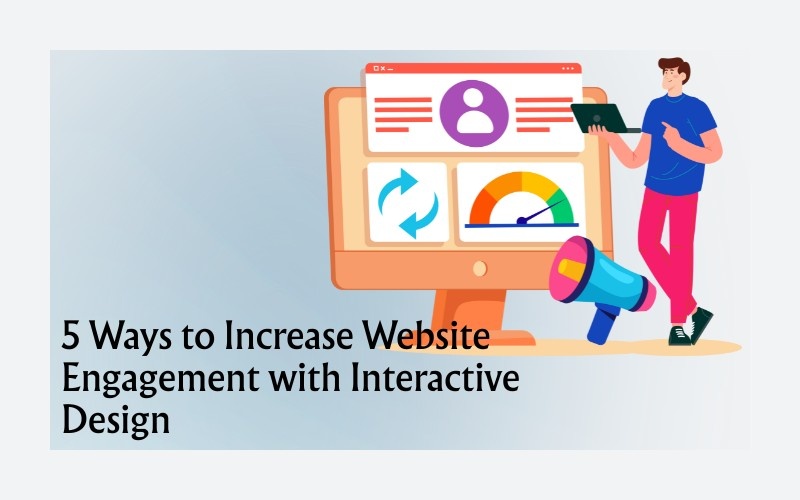This is because in the digital world, where marketing is done at seemingly high speeds, it is now harder than before to capture and retain the attention of a user. In the world with short attention spans and intense competition, a modern user rarely gets what he or she wants out of traditional, static websites. This is the place where an interactive design will not be a fashion but a strategic requirement. Interactive design does not only mean aesthetics -it means establishing real two-way communication that turns passive consumers into active participants. When it is done properly, it could lead to a tremendous amount of time on site, the less bounces, and even conversion.
Designing the interaction brings together the technology, psychology, and storytelling to transmit more power to the user of the journey. Instead of giving information, it encourages users to navigate, interact, and even influence through the information. This not only develops a deeper connection but also develops trust and interest. So, what are some of the powerful ways to engage the visitor to the site using interactive design, and how can it help transform even a stagnant page into an active experience?
Personalization Through Real-Time Interactivity
Product personalization, based on a specific user behavior or preferences, is one of the best means of increasing engagement. Interactivity in real-time enables the websites to react to the activity of a visitor on the spot. As an example, an e-commerce site may switch the homepage product recommendations that it displays based on the categories a visitor has recently viewed. A content-driven site may dynamically show the articles through the history of reading or scrolling.
This is important, especially with the use of AI and machine learning which facilitates intelligent forecasting and responsive layouts. Nevertheless, personalization does not have to be very complicated. Even minor details, such as greeting the users by their names, remembering their preferences, or suggesting something depending on their past attendance, can make the user feel visible and appreciated. Such engagement is particularly useful toward resisting friction and boosting conversion since the users are exposed to the right content at the most appropriate moment.
Notably, privacy should go hand in hand with personalization. Data utilization transparency should be outlined on a website, data control should be optional, and data use should not exceed the limits. Real-time personalization is one of the main contributors to engagement and loyalty when it is done ethically and with respect to user consent.
Gamification and Reward Systems
Games attract human beings. Gamification is based on this intuition, but still, it still brings playful yet goal-oriented elements to what would otherwise be just mere routine interactions with a website. The practical implementation of game mechanics like the use of a progress bar, badge, or points, or even a challenge, can make the thing more engaging, particularly when it is accompanied by a reward or a perceived reward.
As an example, a language learning app may generate streaks, daily targets, and progress graphs so that the user has the motivation to learn and learn regularly. Customers could also be offered discount codes once they have performed some tasks, including writing a review, referring a friend, or even taking a look at new products using an online store. Even a spinning prize wheel pop-up or a quiz providing a personality match can create interest in the use, although it is as basic as this.
This will be successful in gamification since users feel accomplished and stay longer in the process. But then the design must not be gimmicky or exploitative. The best reward programmes are the ones that seem authentic, desirable, and on brand. They are not distractions; these are incentives that add value to the whole experience and help build an emotional investment.
Microinteractions for Enhanced Feedback
Microinteractions are small animations or interface designs that offer instant feedback or walk the users through actions. They are not huge in terms of their size, but have a huge influence on the engagement as they turn the interactions to feel intuitive, responsive, and satisfying. Consider the slightly changed button colour, upon a mouse hover, or the vibration on a form field, when the input is wrong. Such information makes users feel empowered and knowledgeable.
To take an example, after filling in a contact form, a fast loading animation with a confirmation message saying, May make the user rest assured that the form submission was successful. Or in a product configurator, how it sometimes feels as users make selections may be previews that happen instantly. Microinteractions can also help in lowering cognitive load since they can direct the user visually as to what they should do next.
It is not just a look of beauty or a bunch of cosmetic considerations, but it has a very fundamental role to play in communication. They lessen confusion, eliminate mistakes, and guide users as they move around systematically. Intentionally applied and applied regularly, microinteractions allow making the experience more refined and pleasurable, and make users want to engage in it again.

Interactive Content That Invites Exploration
Interactive websites go a step further than a typical website, where one can merely read and view things that are there. These are sliders, tabs, infographics, maps, and timelines to enable users to be actively engaged in reading information in their own way and at their own time. The interactive content is more like discovery and prolongs the engagement of users.
As an example, consider a financial education site where a set of interactive calculators helps visitors to get an idea of how much was saved or how much was spent on loan repayments. Users do not have to read about the advantages of saving: instead, they can enter specific data and observe an individual result. An example of this may be interactive storytelling in which users must choose through branching stories, showing them the various consequences depending on their answers.
The interactive material stimulates inquisitiveness and provides a perception of control. It enables users to customize their experience, thus they have a stronger comprehension, and it becomes easier to memorize. This form of engagement works well, especially with educational, technical-heavy, and product-filled websites in which assistance to make the user aware of complexity can translate into trust and conversion.
Further, interactive content can be a source of solid analytics. Marketers can also keep track of user interaction with the various aspects, the sections they are interested in, and the place of drop-off. Such insights may inform what gets put up in the future, and in this way, the website will get a bit smarter as time goes by, and increasingly responsive to need.
Seamless Conversational Interfaces
This is a significant development since chatbots and conversational interfaces were once very scripted, and so not very organic. Contemporary conversational AI is capable of answering questions, assisting with the choice of products, booking, and providing on-time support. This degree of interactivity makes the value immediate and eliminates the friction of many of the commonly related tasks, which would otherwise have involved maneuvering through numerous pages or completing a complicated form.
This is because conversational interfaces are effective in terms of engagement. After all, they can humanize digital experiences. Rather than going through a list of frequently asked questions, an individual can request the service of a chat robot instead. Rather than spend hours looking through tonnes of products, they can explain what they are seeking and be delivered personal recommendations. This leads to a more expedient, natural process that is more of a dialogue than a business interaction.
Voice search, live chat services, and hybrid human-AI support also increase rates of engagement due to differences in user preferences. Some people would like to talk, type naturally, or receive answers promptly, and scrolling through drop-down menus is not what they are willing to do. Conversational interfaces bring services to the user and make the process of such use easy.
Designers ought to put their efforts into ensuring these systems are transparent, polite, and genuinely helpful. When users become conscious that they are being listened to and their feelings understood, they are in a better position to come back as well as to spread the word to others.
Conclusion
The interactive design is becoming a necessity rather than an option because in the modern digital environment, with so much noise, it is difficult to capture and retain the user’s attention. With the help of customisation, game experiences, microinteractions, interactive content, and conversational tools, the brands will be able to make websites that can engage people rather than merely inform them. This has created more emotional involvement, enhanced the rate of conversion, and provided a memorable user experience.
Because the expectations of the users will only be rising, websites need to respond by becoming more geared toward responsiveness, intuitive systems that serve the needs of people, as well as being humanistic. The key to this change is interactive design. It not only makes usability and functionality better but also builds the type of meaningful connections that turn first-time visitors into loyal brand enthusiasts. In a world where digital music is full of static, interactivity is how your site will be heard.














